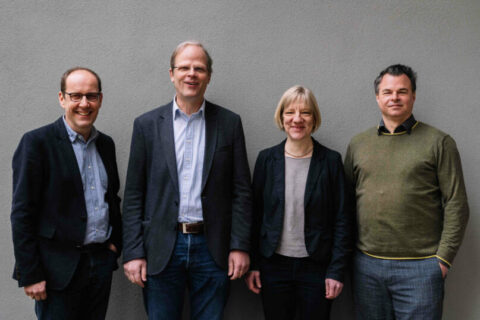Cooperation promotes new findings

In science, the exchange of ideas and resources between researchers from different disciplines forms the foundation for progress and innovation. Cooperation not only increases efficiency, but also promotes new findings. This is why the FAU Profile Center Light.Matter.QuantumTechnologies (LMQ) supports several high-ranking projects between LMQ members and researchers at the Johannes-Gutenberg-University Mainz (JGU) and the University Kaiserslautern-Landau (RPTU). All projects are centered around the integration of quantum and classical processes of light, matter, and spin in new architectures. On the structural level, this is strengthened by the close link between LMQ at FAU and the top-level research area TopDyn (Dynamics and Topology) at JGU and RPTU. Currently, researchers from the three universities are working together in the following four joint projects:
The project “Investigating near-field interactions and spin-dynamics in a diamond-2D material hybrid system” connects Janina Maultzsch from FAU and Elke Neu-Ruffing from RPTU. The goal of the project is to understand the interaction between optical excitations in two-dimensional (2D) layers and nitrogen vacancy (NV) centers in diamond, which have potential as highly controllable quantum systems for sensing. The researchers plan to form 2D heterostructures on diamond and study near-field coupling to NV centers as well as spin-dynamics in these hybrid systems. The interplay between classical functionalization of the 2D layer and the quantum properties of the NV center forms the basis for new quantum-classical functionalities, for example in optimized quantum sensor systems.
The second project aims to build a joint lab between the groups of Joachim von Zanthier from FAU and Ferdinand Schmidt-Kaler from JGU. Scientifically, they investigate the collective spontaneous emission of correlated atoms from a fundamental point of view; the technique can, however, also be used for new approaches for imaging quantum or classical sources. To this end, the originally fully excited atoms are brought into correlated states by measuring photons in the far field, and the properties of the subsequent emission are then studied. The vision of the joint lab is that it can be simultaneously operated by local and remote staff at the two sites. Based on this project, key elements of a future joint virtualized infrastructure for users in Erlangen, Mainz and Kaiserslautern will be demonstrated, and made accessible to any external users.
The project “SiC as a quantum – classical hybrid platform: from classical control of chiral spin structures to quantum detection (SiCQ)” establishes a link between Heiko B. Weber from FAU and Mathias Kläui from JGU. It aims to solve an enigmatic phenomenon in solid-state physics: the interplay between chiral molecules and spin imbalances. While there is evidence that molecular films create spin currents and/or affect the magnetic properties of adjacent surfaces, this project aims to clarify how and why the interaction evolves. It focuses on experiments in which both components are approached until contact with sub-Angström resolution, and the evolving interplay of chiral molecules and magnetic textures is established and observed in ultra-slow motion.
The project “Non-equilibrium information transitions in open quantum circuits: from quantum magnets to radiative effects” involves Kai Phillip Schmidt from FAU and Jamir Marino and Ferdinand Schmidt-Kaler from JGU. It aims at bridging the theory of open quantum circuits with the dynamics of quantum magnets and cooperative effects in optics. Specifically, a novel class of non-equilibrium transitions will be exported from random hybrid circuits to Ising models coupled to non-Markovian baths, in search of a quantum analog of the directed percolation universality class. The long-term vision is to promote a conversion of hybrid circuits into condensed matter and statistical mechanics models relevant for a wide range of researchers in the domain of Light.Matter.QuantumTechnologies.